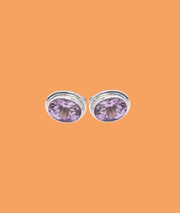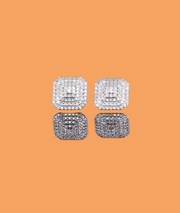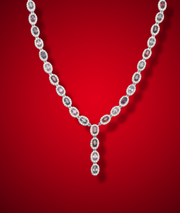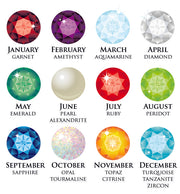In the ancient Babylonian zodiac (which was a 12-month calendar), each month was represented by a specific animal, and the gem that corresponded with each month was also said to be represented by that animal. In a bit modern age each gemstone was associated with a tribe of Israelites, and a tribe of Israelites was associated with each month of the year. The order of the tribes was listed around the outside of the breastplate, starting with the tribe of Judah in the middle, and moving outward to Reuben, Simeon, Levi, Issachar, Zebulun, Joseph, Benjamin, Dan, Naphtali, Gad, Asher, and finally, Joseph again. The number of jewels assigned to each tribe varies by source.
Throughout history, gemstones have been associated with a variety of meanings. In the Bible, gemstones were given to the Israelites as a reward, used to design the Jewish High Priest’s breastplate, and adorn what is known as the “Breastplate of Aaron” – an ancient religious artefact dating back to the biblical era that was said to have been worn by the brother of Moses, Aaron. In ancient Persia, gemstones were believed to provide powers of protection, fertility, wisdom and strength, and were also thought to ward off evil spirits. Many ancient civilizations such as the Greeks, Romans and Chinese also believed in the metaphysical properties of gemstones. The Greeks, for example, believed that each birthstone carried a distinct influence over the body.
Similarly, they were believed to give the wearer divine protection, have healing abilities, and the ability to treat illnesses. They were also thought to possess life-giving qualities, which the wearer would absorb. It was believed that a person could heal themselves simply by “passing” the stone across their body, due to the stones' healing powers. As the human race evolved, the use of gemstones went from practical to purely ornamental – used to adorn jewellery and clothing. In the same way, we categorize birthdays by month, gemstone calendars were also made, where each month corresponded to a gemstone.
JANUARY – GARNET
The biblical meaning of garnet is "comfort". This gemstone is usually associated with the month of January. The month of January is thought to be named after the Roman god, Janus, as the month was named after the god's two faces, one looking back and one looking forward. January was the time of year when the Romans officially welcomed the new year, after the period of the year that was marked by a great festival of Saturnalia. There are two varieties of garnet: almandine and pyrope. The most common garnet is the deep red-coloured almandine, the redder the better. It is closely followed by the purplish-red pyrope and a pale green variety called verdelite. Garnets are found in all areas of the world, however, they are best known from Africa, Europe, India, Madagascar.
FEBRUARY – AMETHYST
Amethyst is a variety of quartz, which is a highly energetic and common mineral, formed from silicon and oxygen. The colour of amethyst comes from traces of iron and other impurities. Amethyst is probably one of the most popular, and common, of all the crystals available to people interested in the metaphysical arts. It is used extensively in jewellery and is also present in many other forms, such as carvings, amulets and even as an additive to wine and other liquids. Its attractive purple colour makes it perfect for this purpose and it is often one of the first crystals people buy. It is a stone that is very easy to work with, as it will gently grow accustomed to your energy and will settle into your space very easily. This makes it a good stone for beginners and for those who prefer working with a smaller number of crystals.
MARCH – AQUAMARINE
Ancient seer's believed that aquamarine contained the power of the sea, the rain, and the sky. Aquamarine, a member of the beryl family, was mined in Brazil as early as the 16th century. Today, most aquamarine is mined in Brazil, Afghanistan, Zambia and Nigeria. Small amounts of aquamarine are found in California, India, Madagascar, Norway, and Russia. Aquamarine is often treated (coated) to improve its colour or clarity. The most common treatment is to heat the stone in a vacuum, which causes the stone to become greener and lose some of its blue colours. Aquamarine is the traditional birthstone of March and the zodiac stone for Aries. It is a stone of the sea, and a stone of courage, friendship, and trust. Aquamarine is known to protect the wearer from the poison of snakes and to ease the pain of childbirth.
APRIL – DIAMOND
Diamonds are found in the earth's oldest rocks and are believed to have their origins in stars. There are only a few places on earth where diamonds are found in a pure state; in most places, impurities occur in the stone. These impurities, called "inclusions", are the result of the way the stone was formed. The inclusions, which are almost always non-crystalline materials, cause the colouring of the stone. For example, the inclusions in a pink diamond are the result of radioactive elements which cause the stone to be a pale rose colour. The inclusions in a yellow diamond are the result of chemical elements which cause the stone to be a bright yellow colour. The word diamond comes from the Greek word Adamas, meaning "hard".
MAY – EMERALD.
this is considered the gemstone of the month of May. Emeralds have also been traditionally associated with many positive qualities. It was said that a person wearing an emerald would be protected from envy, slander and lies. It was also said that emeralds had the power to grant their wearer wisdom, success and protection from deceit. The emerald is believed to bestow upon its wearer the power to foretell future events. The wearer of this stone was said to be able to understand the language of animals and predict when storms would cause illness. Emeralds were also said to prevent the wearer from falling ill with fevers and to protect them from poisons.
JUNE – PEARLS
The pearl was a valued gem in ancient times and jewellery made with pearls was worn by royalty. Pearls have been tirelessly sought since ancient times. The ancient Chinese traded silk and spices for freshwater pearls, which they collected and sold. The Romans adored pearls and they became a beloved symbol of purity, while the Japanese found pearls to be a natural symbol of longevity. Pearls are formed by an oyster, or mollusc when an irritant is introduced into the mollusc’s shell. The mollusc produces a substance to close the opening, but instead of closing the opening, the mollusc secretes a substance that becomes a pearl. Pearls were traditionally given as a symbol of honour, respect, or friendship. Today pearls are symbols of purity, fertility, and femininity.
JULY – RUBY
Ruby is associated with the planet Mars, and thus, the God of War. According to Winfried Schumann, the ruby was worn by Roman soldiers to protect them from the hostile forces of Mars. It is said that the God of War, Mars once fell in love with a human, named Anahita, who wore the ruby. Mars lost the battle to love and was forced to give the gemstone to Anahita to keep her happy. All these fascinating tales about the ruby have been around for centuries and have always kept the ruby in the limelight. After diamonds and sapphires, the ruby ranks third place among the most expensive gemstones in the world. Not every red gemstone is ruby. The red colour of the ruby comes from a variety of chromium. Rubies are also considered to be "precious" gemstones but can be cut in a variety of different shapes.
AUGUST – PERIDOT
Peridot is incredibly calming and soothing to the heart. Its marvellous matrix of healing energy warms the heart and makes the soul smile. It’s excellent for those who feel burdened by life’s troubles, and it can help you to see things on a more positive plane. Peridot assists one to find pleasure in life’s simple delights and it helps one to trust more easily. It’s an all-purpose stone that’s excellent for achieving balance and harmony in all areas of life.
SEPTEMBER – SAPPHIRE
For centuries, sapphires have been thought to protect their wearer from harm, bring him health and long life. They were thought to soothe rheumatic conditions and to fortify the brain against forgetfulness and the evil effects of witchcraft. It is also believed that sapphires make the wearer a more persuasive speaker and that he can carry out his work more effectively when the stone is placed under his tongue. Sapphires are also thought to be a potent love charm, able to arouse love in others and to prevent others from falling out of love. For centuries, sapphires have been thought to protect their wearer from harm, bring him health and long life. They were thought to soothe rheumatic conditions and to fortify the brain against forgetfulness and the evil effects of witchcraft. It is also believed that sapphires make the wearer a more persuasive speaker.
OCTOBER – OPAL
It is said that these precious stones were created from the memory of this rainbow that remains in the opal. Others believe that the opal was formed from the first tears of the earth. It is said that every tear of pain and sorrow has been preserved in the opal as it weeps at its insuperable power over the earth. From ancient times, this precious stone has been associated with the sky, rainbows, water and fire. The ancient Romans believed that the opal had fallen from the sky and was bestowed with the power of rain. The Romans also believed that an opal that was red in colour brought good luck and physical strength to the owner of the opal. The Romans also believed that an opal with a fire-like gleam brought good luck to the owner who had a good sense of direction in life.
NOVEMBER – CITRINE
This happy colour is amplified by the stone's subtle flashes of orange, red, and gold. Citrine is a wonderful stone for creating happiness wherever it is placed and is a natural energy generator. Citrine is also known as the Merchant's stone, as it is said to bring prosperity to its owner by attracting money, and is a powerful source of abundance. It is also believed to attract love and prosperity to the area where it is placed. The swirls of colour in this Citrine bring soothing energy to the area in which it is placed, and it can also help to calm the mind and relieve stress, making it a natural ally for meditation. This is a great stone to wear to a job interview - it will open you up to receive good vibes and the right opportunities, and the employer will sense your enthusiasm and optimism.
DECEMBER – TANZANITE
Tanzanite is a rare gemstone that is only found in a relatively small region of Tanzania. It is especially popular in Tanzania, the United States, and the United Kingdom, where it is a symbol of luxury and wealth. Though Tanzanite is a relatively new gemstone, it has a rich and interesting history that dates back many years. Tanzanite is a gem known by many different names and has been confused with other gemstones.









